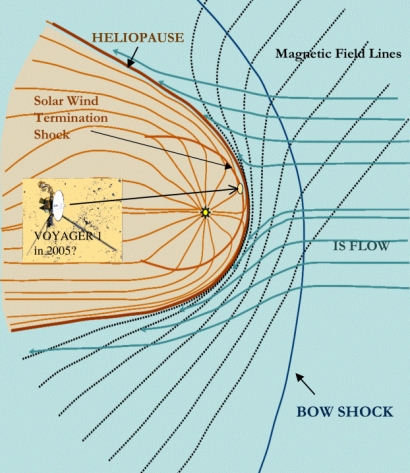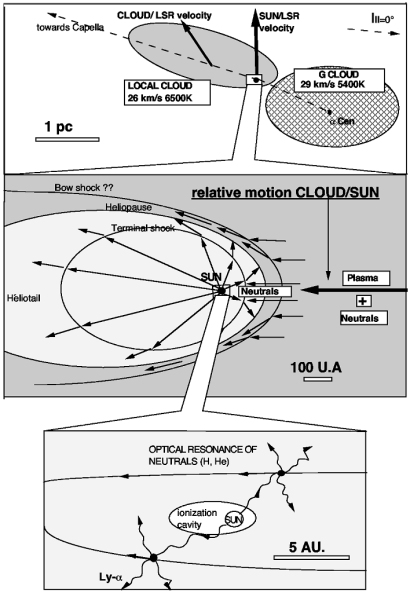The Distortion of the Heliosphere: our Interstellar Magnetic Compass
14 March 2005
Measurements by the SWAN instrument onboard SOHO, have shown that the heliosphere, the solar wind filled volume which prevents the solar system from getting embedded in the local (ambient) interstellar medium is not axi-symmetrical, but is distorted, very likely under the effect of the local galactic magnetic field.From the measured distortion it is possible to determine the direction of this field, and future models will hopefully derive its intensity. This is the last missing ingredient required for a precise model of the heliosphere, including its size and shape. These results are in agreement with theoretical models developed to explain the recent data recorded by Voyager 1, suggesting that the spacecraft, which is cruising at a distance of 14 × 109 km from Earth, is indeed beginning to encounter the solar wind shock at the front of the heliosphere.
The Heliosphere
The Sun and its planetary system travel through the ambient galactic gas at about 100 000 kilometers per hour. All are shielded from the ionized galactic gas and from most of the cosmic energetic particles by the permanent and omni-directional flow of fast and magnetized gas emitted continuously by our Sun – known as the solar wind. This wind serves to redirect the incident ionized galactic gas and cosmic rays, and forces them to flow around the solar system. This protecting bubble of solar gas, which moves with the Sun, is called the heliosphere. Paradoxically, although being a large scale shield against the galactic medium, the solar wind would in itself be harmful to the Earth were it not for its magnetic field act as a local shield.
 |
|
The distorted heliosphere (adapted from Pogorelov and Zank (2004), Ratckiewicz et al (2002)). The Sun (yellow) is moving to the right. There is no longer any symmetry of the heliosphere with respect to the axis defined by the Sun and the direction of the incoming wind (The Sun-Local cloud relative velocity). If The SWAN results are correctly interpretated, Voyager I is moving towards the less compressed side of the heliopshere. The distance in 2005 between the Earth and Voyager 1 (launched in 1977) is about 14 × 109 km. |
The Voyager 1 Controversy
The interstellar ionized gas cannot enter the heliosphere and flows at its periphery. The majority of the high-energy particles that travel through the galaxy are also rejected by the solar magnetic field fluctuations carried by the solar plasma. Extremely high-energy particles can enter, but they are much less numerous. A discontinuity, which separates the solar and the galactic gases, characterize the fore part of the heliosphere, in the direction of the Sun's motion through the galactic medium. Before reaching this surface, the solar wind is decelerated by a strong shock front - the solar wind termination shock. No human object has left the heliosphere, but the Voyager 1 spacecraft, which, after 10 000 days of cruise is at about 94 AU (14 × 109 km), is heading towards the northern ecliptic hemisphere and the edge of the heliosphere.
About 10 years ago the size of the heliosphere was estimated with an uncertainty of about 5-10%. The first measurements from Voyager, however, are significantly different from the expectations and a lively controversy started last year. Voyager 1's instruments recorded energetic particle enhancements with distribution characteristics exactly as if it had already crossed the shock. But magnetometers indicate that Voyager 1 is still in the pre-shock solar wind. A possible explanation recently devised by theoreticians from the University of Tucson (Arizona), is the existence of an offset of the heliosphere from the direction of the incoming interstellar wind.
SOHO-SWAN Measurements
The interstellar gas contains some neutral atoms. Those particles, because they do not feel the electromagnetic field associated with the solar wind, can cross the discontinuity and invade the heliosphere. They represent the dominant species in the heliosphere beyond the orbit of Jupiter, but because they are both low in energy and neutral they are not harmful. The SWAN instrument on SOHO detected some of these interstellar particles (hydrogen atoms) and recorded their velocities. This is achieved by observing the radiation re-emitted excitation of the hydrogen atoms by ultra-violet photons from the Sun. Using two independent methods, SWAN measurements demonstrate that the direction of incoming hydrogen atoms is offset by about 4 degrees from the direction of incoming gas, (measured differently to avoid systematic errors). The phenomenon at the origin of this deflection is very likely the same phenomenon, which is the cause of two effects detected previously by SWAN: the slowing down and the heating of the hydrogen flow. It is likely that a partial coupling between the neutral atoms and ionized particles results in a transfer of a fraction of the ionized gas motion and thermal energy onto the neutral flow. Indeed, previous SWAN measurements have allowed refinement of the heliosphere's size.
Flow Direction
If the flow of hydrogen atoms deviates from the initial direction, then the ionized gas flow, which has affected it, is not axi-symmetric, and that the heliosphere is distorted. The galactic magnetic field is most likely responsible for this distortion.
From observations of starlight the average magnetic field intensity in our galaxy can calculated. It is believed to be strong enough that the exerted pressure can have a significant influence on the heliosphere.
It would be an unlikely coincidence if the direction of the local galactic field, which depends on the shapes and motions of the interstellar clouds in the solar neighbourhood and of their history, were exactly parallel or perpendicular to the wind axis. If, as it is more probable, it is inclined with respect to the direction of motion, then the magnetic pressure exerted on one side of the axis must be different from the pressure on the opposite side (see scheme). From the knowledge of the distortion, it is possible to infer the direction of the galactic magnetic field. The heliosphere, and the neutral flow act as a giant magnetic compass for the galactic field. Future models should allow inference of its intensity.
Consequences for Voyager 1
According to SWAN results, Voyager 1 is not following the optimum trajectory for escaping the solar wind. The spacecraft is heading towards the less magnetically compressed part of the upwind part of the heliosphere. Since the spacecraft trajectory was optimised for planetary encounters it would have been good fortune had the heliospheric interface crossing also been optimium. On the plus side, the spacecraft (as well as Voyager 2) is moving upwind and not towards the tail.
This measured distortion is of great significance and theoreticians can fit the data into the more recent models developed to explain the Voyager data.
Interstellar Cloudlets in the Sun Vicinity
The distribution and shape of the interstellar clouds can be deduced from absorption lines in the spectra of nearby stars. We are in a group of small and tenuous clouds, and that the Sun will exit from the one of those clouds, the local cloud, in less than 2000 years, and later enter a neighbouring cloud.
The cloud shapes are very imprecisely known, but, if one compares the direction of the local galactic magnetic field derived from SWAN with the cloud distribution, one sees that field lines are more or less tangential to the boundary between the two clouds, as if the field were compressed between them, in agreement with theory. It does, however, fit the direction deduced from stars located at about 20 parsecs or more (1 parsec=3.086 × 1013 km), probably a sign of significant lack of homogeneity.
 |
|
The two closest interstellar cloudlets. The Sun will exit the local cloud (in less than 2000 years) and enter a slightly cooler cloud (the G cloud). The solar wind is carving a bubble inside the cloud, the heliosphere (middle). Neutral atoms observed by SWAN enter the heliosphere and can be observed becasue they scatter the solar UV light. |
This is an abridged version of paper that appeared in Science, 4 March 2005, by Lallement et al. The full paper can be downloaded by following the link on the right.
